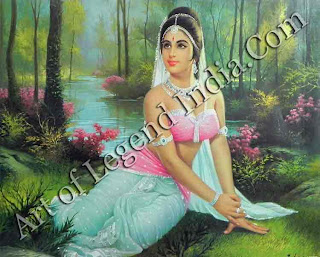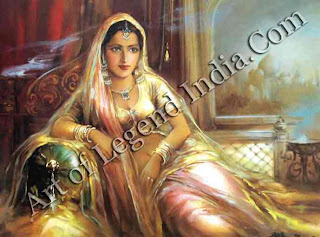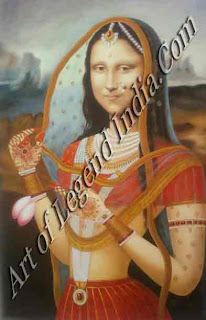The
Vishnudharmottara commends the ability of the artist who could effectively
paint wavy lines, flames, smoke and flags to indicate the direction of the
wind. The artist who could, in his pictures, clearly show the distinction
between the sleeping and the dead is rated equally high.
Like
the poet and the musician, the artist in ancient India also had elaborate
canons of criticism to understand and judge merits and defects in pictures. A
passage in the Upamitibhavaprapanchakatlui mentions the several factors that go
to make a good picture: "Here is a fine drawing, delicately drawn in an
unobtrusive line, coloured gay in bright colours, with relief suggested by
modelling; with the element of ornamentation appropriately introduced,
symmetrical portrayal of body, emotion and joy executed in really admirable
manner."
But above all, beyond the beautifully prepared ground, the sure
line, the charm of the colour and the shade suggesting depth, there is
something more important that makes the picture a masterpiece and arrests attention,
and that is the master artist's stroke, chitrasyeva manohari kartuh kim api
kausalam (Vakroktijivita, III). Symmetry, foreshortening, strength in drawing,
beauty in colour and other merits enhance the charm of a picture, while coarse,
weak and vague drawing, lack of symmetry, muddling of colours, bad pose, lack
of emotion, dirty execution, lifeless portrayal and other defects detract from
the value of the painting. The Vishnudharmottara enumerates both.
 The
element of suggestion in pictures enhances their charm and establishes the
superior skill of the artist who could produce such. The dress of a princess
gives a clue to her virginity; the mode of worship of a rishikumara suggests
the time of the day as at Mahabalipuram where the hermit holding his hands in
yamapasamudra to peep at the sun during the suryopasthana suggests midday.
The
element of suggestion in pictures enhances their charm and establishes the
superior skill of the artist who could produce such. The dress of a princess
gives a clue to her virginity; the mode of worship of a rishikumara suggests
the time of the day as at Mahabalipuram where the hermit holding his hands in
yamapasamudra to peep at the sun during the suryopasthana suggests midday.
Minute
details as even the shape of hair like kuntala, dakshinavarta, taranga,
simhakesara, etc., the measurement of limbs in general according to tala
proportions, different shapes of eyes like chapakara, mats yodara,
utpalpatrabha, etc., poses or sthanas like rijvagata, ardharju, etc., different
methods of foreshortening or lcshayavriddhi, the methods of shading like patra,
raikhika, binduja, the modes of representing a variety of subjects chosen for
delineation like kings, courtiers, courtesans, warriors, animals, rivers, etc.,
and several other art themes, which compose detailed canons of art criticism
are discussed in the Chitrasutra of the Vishnudharmottara, which was an accepted
textbook for artists and sculptors and nagarakas for a good general equipment
in fine arts. It also shows that ancient India could boast of a highly evolved
science of art criticism.
 What
wonder then, if under such favourable conditions, the artist did very well? If
the ivory carvers of Vidisa, who practised different mediums, could carve in
stone as easily as they could paint with a brush and produce the Sanchi
gateway, it is no wonder that a king on his elephant, who approached an ivory
carver at work, covered all over with ivory dust, lost in his own work,
unconscious even of the presence of the ruler so close to him, as given in
early Buddhist texts, longed very much indeed that he himself were just a
wonderful creative carver in ivory rather than the ruler in his dazzling palace
that he was.
What
wonder then, if under such favourable conditions, the artist did very well? If
the ivory carvers of Vidisa, who practised different mediums, could carve in
stone as easily as they could paint with a brush and produce the Sanchi
gateway, it is no wonder that a king on his elephant, who approached an ivory
carver at work, covered all over with ivory dust, lost in his own work,
unconscious even of the presence of the ruler so close to him, as given in
early Buddhist texts, longed very much indeed that he himself were just a
wonderful creative carver in ivory rather than the ruler in his dazzling palace
that he was.
Writer-C.SIVARAMAMURTI
 The
element of suggestion in pictures enhances their charm and establishes the
superior skill of the artist who could produce such. The dress of a princess
gives a clue to her virginity; the mode of worship of a rishikumara suggests
the time of the day as at Mahabalipuram where the hermit holding his hands in
yamapasamudra to peep at the sun during the suryopasthana suggests midday.
The
element of suggestion in pictures enhances their charm and establishes the
superior skill of the artist who could produce such. The dress of a princess
gives a clue to her virginity; the mode of worship of a rishikumara suggests
the time of the day as at Mahabalipuram where the hermit holding his hands in
yamapasamudra to peep at the sun during the suryopasthana suggests midday.  What
wonder then, if under such favourable conditions, the artist did very well? If
the ivory carvers of Vidisa, who practised different mediums, could carve in
stone as easily as they could paint with a brush and produce the Sanchi
gateway, it is no wonder that a king on his elephant, who approached an ivory
carver at work, covered all over with ivory dust, lost in his own work,
unconscious even of the presence of the ruler so close to him, as given in
early Buddhist texts, longed very much indeed that he himself were just a
wonderful creative carver in ivory rather than the ruler in his dazzling palace
that he was.
What
wonder then, if under such favourable conditions, the artist did very well? If
the ivory carvers of Vidisa, who practised different mediums, could carve in
stone as easily as they could paint with a brush and produce the Sanchi
gateway, it is no wonder that a king on his elephant, who approached an ivory
carver at work, covered all over with ivory dust, lost in his own work,
unconscious even of the presence of the ruler so close to him, as given in
early Buddhist texts, longed very much indeed that he himself were just a
wonderful creative carver in ivory rather than the ruler in his dazzling palace
that he was.












0 Response to "Canons of Art Criticism "
Post a Comment